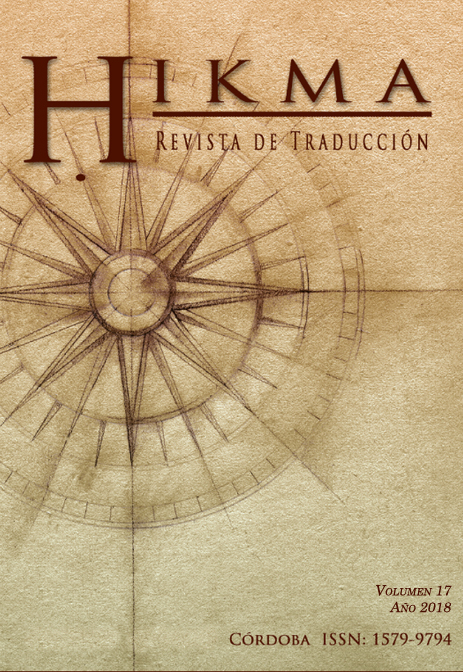Carmen Ardelean. Translating for the Future. What, How, Why do we Translate? București: Tritonic, 2016, 203 pp, ISBN 978-606-749-133-3
Main Article Content
Abstract
Downloads
Article Details

This work is licensed under a Creative Commons Attribution-NonCommercial-ShareAlike 4.0 International License.
Authors who publish with this journal agree to the following terms:
1. Authors retain copyright and grant the journal right of first publication with the work simultaneously licensed under a Creative Commons Attribution License that allows others to share the work with an acknowledgement of the work's authorship and initial publication in this journal.
2. Authors are able to enter into separate, additional contractual arrangements for the non-exclusive distribution of the journal's published version of the work (e.g., post it to an institutional repository or publish it in a book), with an acknowledgement of its initial publication in this journal.
3. Authors are permitted and encouraged to post their work online (e.g., in institutional repositories or on their website) prior to and during the submission process, as it can lead to productive exchanges, as well as earlier and greater citation of published work (See The Effect of Open Access).
References
ARHIRE, Mona. Corpus-based Translation for Research, Practice and Training. Iași: Institutul European, 2015.
BAKER, Mona. In Other Words. A Coursebook on Translation. London and New York: Routledge, 1992. DOI: https://doi.org/10.4324/9780203327579
CHIFANE, Cristina. Translating Literature for Children. Cluj-Napoca: Casa Cărții de Știință, 2016.
COZMA, Mihaela. Translating Legal-Administrative Discourse: the EU Legislation. Timișoara: Editura Universității de Vest, 2006.
DEJICA-CARȚIȘ, D. Thematic Management and Information Distribution in Translation. Timișoara: Editura Politehnica, 2010.
DIMITRIU, Rodica. Theories and Practice of Translation. Iași: Institutul European, 2002.
DIMITRIU, Rodica. The Cultural Turn in Translation Studies. Iași: Institutul European, 2005.
GILE, Daniel, HANSEN, Gyde and POKORN, Nike (eds.). Why Translation Studies Matter. Amsterdam and Philadelphia: John Benjamins, 2010. DOI: https://doi.org/10.1075/btl.88
GREERE, Anca. Translating for Business Purposes. Cluj-Napoca: Dacia, 2003.
LUNGU-BADEA, Georgiana. Tendințe în cercetarea traductologică. Timișoara: Editura Universității de Vest, 2005.
LUNGU-BADEA, Georgiana. Scurtă istorie a traducerii. Repere traductologice. Timișoara: Editura Universității de Vest, 2007.
MOSSOP, Brian. ‘What shoud be Taught at Translation Schools?’. In Pym, Anthony et al. (eds.). Innovation and E-learning in Translator Training: Reports on Online Symposia. Tarragona: Intercultural Studies Group, 2003, pp. 20-23.
NICOLAU, Felix. Morpheus. From Words to Images. Intersemiotic Translations. București: Tritonic, 2016.
PÂRLOG, Hortensia, Pia Brînzeu, Aba-Carina Pârlog. Translating the Body. Iași: Institutul European, 2009.
POSTOLEA, Sorina. Translation Patterns at Term Level. A Corpus-based Analysis in the Specialized Language of ICT. Iași: Institutul European, 2017.
PYM, Anthony. Email interview for Fedorov Readings, Institute of Translation and Interpretation, St. Petersburg State University. Available: http://usuaris.tinet.cat/apym/on-line/research_methods/2010_interview.pdf [Accessed by the author December 2014].
RAY, Rebecca and KELLY, Natalie. Reaching New Markets through Transcreation. Why Translation just isn’t Enough?. Massachusetts: Common Sense Advisory, 2010.
TOURY, Gideon. ‘The Notion of ‘Native Translator’ and Translation Teaching. In Wills, Wolfram and Gisela Thome (eds.). Translation Theory and its Implementation in the Teaching of Translating and Interpreting. Tübingen: Narr, 1994, pp. 185-192.
VÎLCEANU, Titela. Translation. The Land of the Bilingual. Craiova: Universitaria, 2003.
VÎLCEANU, Titela. Fidelitate și alteritate lingvistică și culturală. Problematica traductologică a sinonimiei în limbile franceză și engleză. Craiova: Universitaria, 2007.

